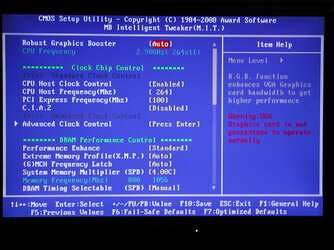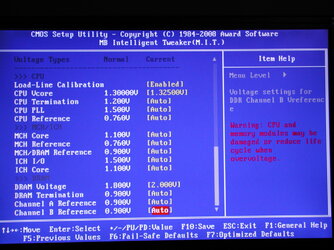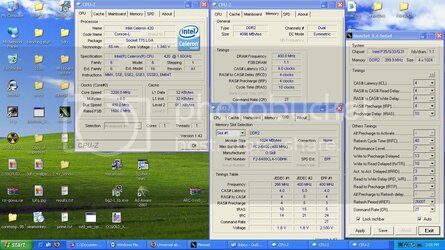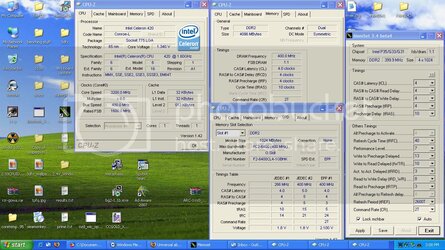- Joined
- Dec 14, 2010
I have run into an unusual problem here.
I have a Celeron 450 in one of my 775 boards (EP45-UD3P) and am attempting to overclock it.
Problem is I can't get the memory to run at its rated speed of DDR2-1066MHz. Any time I increase the memory clock speed to around or above 1000MHz the system won't boot up, but if I drop down to the next multiplier/divider lower then the system boots up and runs normally at the same FSB and CPU clock speed with no changes to any voltages. This is very odd because I've never had any issues with this memory kit running 1066MHz, and have had it above 1100MHz without any problems.
The memory is a 2GB (2x1GB) set of Crucial Ballistix .16FD3's (Micron D9), so with the right voltage and timings these should be able to run at 1200MHz+ without any problems.
They're rated to DDR2-1066 with 5-5-5-15 timings @ 2.2V, though I've found they normally run fine with just 2V. I've currently got them running at 850MHz with 5-5-5-15 timings @ 2V.
Anyone have any ideas as to what might be wrong, or a possible solution?
I have a Celeron 450 in one of my 775 boards (EP45-UD3P) and am attempting to overclock it.
Problem is I can't get the memory to run at its rated speed of DDR2-1066MHz. Any time I increase the memory clock speed to around or above 1000MHz the system won't boot up, but if I drop down to the next multiplier/divider lower then the system boots up and runs normally at the same FSB and CPU clock speed with no changes to any voltages. This is very odd because I've never had any issues with this memory kit running 1066MHz, and have had it above 1100MHz without any problems.
The memory is a 2GB (2x1GB) set of Crucial Ballistix .16FD3's (Micron D9), so with the right voltage and timings these should be able to run at 1200MHz+ without any problems.
They're rated to DDR2-1066 with 5-5-5-15 timings @ 2.2V, though I've found they normally run fine with just 2V. I've currently got them running at 850MHz with 5-5-5-15 timings @ 2V.
Anyone have any ideas as to what might be wrong, or a possible solution?
Last edited:




